#temiar
Photo

Had another great doodle session on Aggie!!!
Thank you for everyone who joined!!
#shikatema#chokarui#shinki#gaara#rock lee#kankurou#chouji#choji#karui#shikamaru#temiar#naruto#boruto
594 notes
·
View notes
Text
I finished the Scholomance series and I am absolutely convinced that I understand it better than literally anyone else. This is directly related to my recent trip down Transformers fanfiction.
#also related is my friend liveblogging the temiare series at me#between all of this i deeply understand the decades long thought process behind the theme of scholomance#i will at some point write this into an essay#and not just a six hundred word text to my father#the scholomance#golden enclaves
121 notes
·
View notes
Text
KISAH SUNGAI WIAS TERCEMAR DAN ORANG ASLI TEMIAR!
#sungaiwias #orangaslitemiar #sungaiwiasguamusang
youtube
View On WordPress
0 notes
Text
no actually biar jujur saja walau hipokrit mana pun: kita mahu sembang hak lgbt di negara kita tapi tak tembus sebab ketagih sangat bahasa penjajah ni, mahu acah pandai guna kata-kata tular di dunia pertama yang hanya sekadar faham kesusahan dari sudut pandang cetek. lihat di negara tetangga malah masyarakat lgbt tempatan mereka berwacana dalam bahasa indonesia.
padahal punyalah banyak bahasa tempatan kita. melayu kantonis hokkien hakka tamil malayalam telugu kannada kadazan dusun sungai murut rungus iban bidayuh lunbawang kayan kenyah semai temiar jahhut ah macam-macamlah. kalau betul mau serius tak payah berbahasa asing, buat lagak saja begitu. paling tidak pun biarlah nampak sikit kaupijak bumi nyata
3 notes
·
View notes
Text
Pada awal pasca Merdeka, Putrajaya menuntut kerajaan Kelantan, syarikat swasta kerana melanggar hak tanah Orang Asli | Malaysia
Pada awal pasca Merdeka, Putrajaya menuntut kerajaan Kelantan, syarikat swasta kerana melanggar hak tanah Orang Asli | Malaysia
Dalam satu kenyataan, Thomas menggambarkan langkah itu sebagai yang pertama seumpamanya sejak Merdeka. – Gambar oleh Mukhriz Hazim
KUALA LUMPUR, 18 Jan (Bernama) – Dalam satu langkah yang tidak pernah berlaku, kerajaan persekutuan telah memfailkan saman sivil terhadap kerajaan negeri Kelantan dan agensinya, bagi pihak Orang Asli Temiar, untuk menghalang kemusnahan tanah asli untuk keuntungan…
View On WordPress
0 notes
Link
The Orang Asli community from Gerik in Hulu Perak have asked to be left alone by religious preachers after claiming to being ‘Islamised’ without their consent.
A group of 35 Temiar ethnics from the villages of Kampung Tasik Asal Cunex, Kampung Ong Jelmol, Kampung Sungai Leyef, Kampung Sungai Papan, and Kampung Pos Pia were in Parliament today to hand over a memorandum of understanding to government.
The group’s spokesman, Anjang Aluej, said that the issue has been ongoing for many years, with many finding their religion had been registered under Islam, in their identitification cards, despite not having converted in the first place.
“It is a big offence to us as we should be given prior and informed consent before such changes are made,” he told reporters here.
Anjang also said at present, Orang Asli children are being taught Islam in schools and forced to fast, against their parents’ wishes.
“It is as if we do not have the freedom to choose our religion. Not only we are we slowly losing our land, we are also losing our identity.
“I would like to also emphasise that this also applies to Christian proselytisers who come into our villages to spread the Christian faith. Please leave us and our customs alone,” he said.
The group’s memorandum also protested against the logging and tin mining activities at the Orang Asli’s traditional lands (tanah adat), and plans for hydro-electric dams which could inundate traditional lands with no compensation for them.
“Other issues which we are concerned about include illegal hunting by outsiders in our lands, and the presence of foreigners in our villages without prior notice.
“As well as this, mothers are being forced to take family planning medications without reason, and the frequent bullying and discrimination by our children in schools, which have caused us to lose faith in the system to defend our rights,” Anjang said.
The memorandum was received by Orang Asli Development Department director-general Prof Juli Edo.
65 notes
·
View notes
Text
“Language Vitality In Malaysia”

We were in KL yesterday for these talks about indigenous languages. Missed the first two (damn you, KL traffic!) - but the one we did catch was enlightening.
+
Paolo Coluzzi, from UM's Linguistics school, presented the "Expanded Graded Intergenerational Disruption Scale" (EGIDS), a 13-point framework to roughly gauge a language's health.
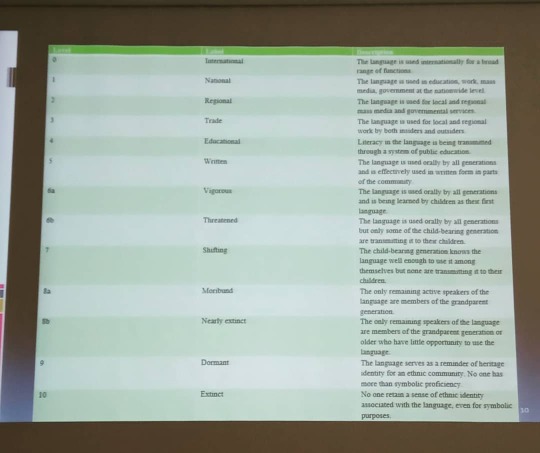
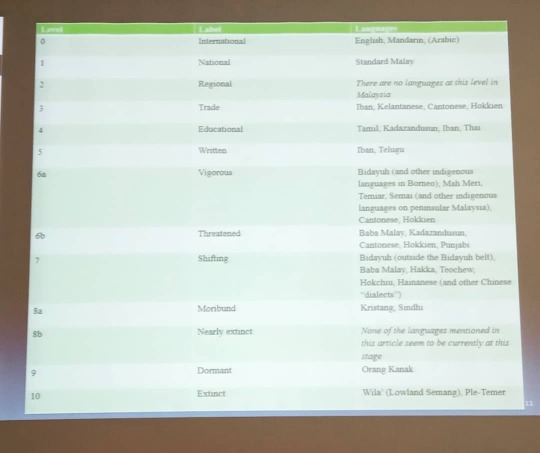
Iban and Kelantanese are influential "Trade" languages. Bidayuh and Temiar are "Vigorous"- still in heavy oral use, and transmitted from parents to children. Kristang is "Moribund"- only the grandparent generation speaks it; once they are gone it is lost.
+
Why do languages die?
Folks move to the big city. They speak BM or English for work. Or they marry outside their language community- inevitably the household language tends towards BM, the language both partners know.
Underlying these specifics is the general logic of nationalism. "We are one nation, we should speak one language." The architecture of Malaysian education enforces that.
As well as the logic of modernity. The veneer of prestige that languages like English or Mandarin have - cultural sophistication; global-economic advantage. City languages. What's the utility of learning a kampung language like Baba Malay, in the face of *those*?
+

Paolo: "The only way would be to try and deconstruct the ideology of the 'new' and modernity, to expose its irrationality and its limits with clarity, and to highlight the positive aspects of tradition and the small-scale economy that used to be part of it."
+
There was a short Q&A afterwards. Folks were engaged. There were artists and activists from the indigenous community, linguists, students:
"There are five different kinds of Bidayuh. Which will be taught in the classroom, if the language is taught in school?"
"The issue is that when research begins, the language is already dying ..."
"You can start small. Write down the words your family uses, their meanings. Record your grandparents' stories. Start now."
"Don't think that, just because you are not Orang Asli, you cannot or should not learn these languages, or focus your research on them. We need everybody!
+
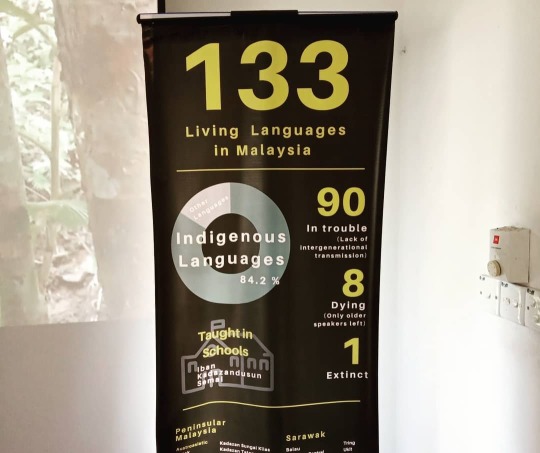
The sense that apocalypse is here - but there *is* space on the boat for you, and we need as many hands as we can get to row.
+
The talks were part of the Centre for Malaysian Indigenous Studies’ “Voices of the People” show -- an exhibition about indigenous languages in Malaysia.
Art. Lots and lots of stories. Videos of folks talking about their daily lives, in Semelai and Che Wong and Mah Meri.
Here’s a animated short of the Sang Kancil & Sang Buaya story, narrated in Temuan:
🐊🐊🐊
How to cross a river via crocodile. The Sang Kancil and Sang Buaya story, narrated in Temuan!
🐀🦌🐀
At the Centre for Malaysian Indigenous Studies, Universiti Malaya. #indigenousstudies #crocodilestudies pic.twitter.com/VZZot8n3MP
— Zedeck Siew (@zedecksiew) October 5, 2019
You should go for this exhibition. It is lovely, and very moving.
12 notes
·
View notes
Photo
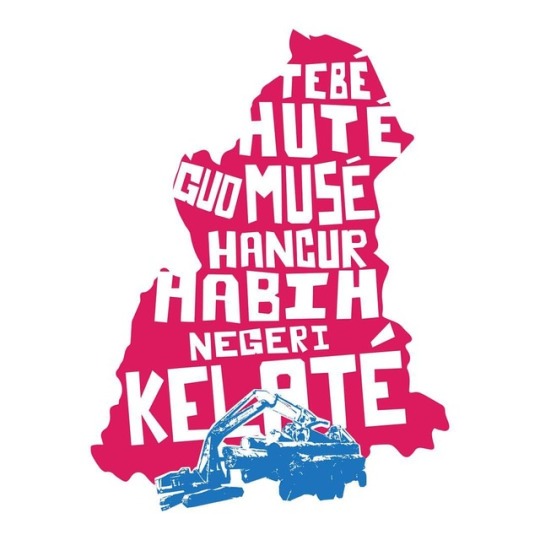
#solidaritiorangasliguamusang #blockade #orangasli #temiar #guamusang #kelantan
0 notes
Link
AS the nation counts down to Merdeka, the Orang Asli in Gua Musang do not feel like they are equal citizens despite being the oldest residents of the land that is now called Malaysia.
This is because their claims to tribal lands that they have used for generations are still not recognised by the Kelantan government.
Yesterday, they were dealt another blow to that fight for their rights when the blockades they erected to protect their land claims were destroyed by state government agencies.
After being up for close to eight months, the barricades they built and maintained were dismantled as they watched on with silent tears and heavy hearts.
Now, there is nothing to prevent plantations companies and loggers from entering and further destroying the communal jungles they have depended on for generations for sustenance.
As Temiar activist Mustafa Along puts it – everyone else feels like they have been liberated or “merdeka”, but not the Orang Asli. “We have been denied our rights as equal citizens.” – August 28, 2018.
#Orang Asli#Malaysia#Southeast asia#indigenous peoples#indigenous people#land rights#land access#patrimony#Kelantan
35 notes
·
View notes
Text



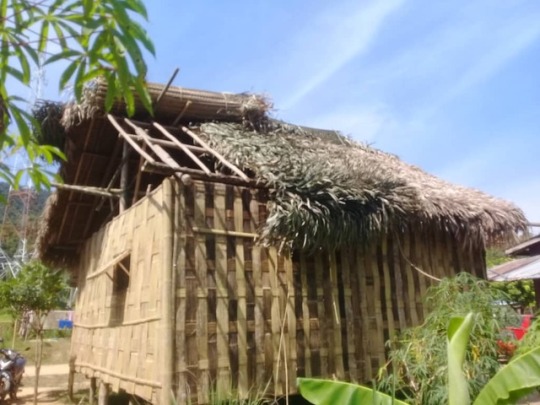
PUSTAKA TEMIAR
My first project to aborigine of Temiar. Located at POS PULAT, near Gua Musang, kelantan. Malaysia. It was the 1st ever build with original consept and material too.
Perhaps it will sustain and benefit to all. Also to reminds one of the plan of Belated Angah Bin Jelid (Tok Batin) the leader community. Target to finish by March 2019, fill with a lot of book and some furniture. Next will install electricity
1 note
·
View note
Text
一
,sunday woke up by 4:50am just now. 一,sekumpulan Orang Asli yang mewakili suku Temiar hari ini menyerahkan memorandum kepada Pejabat Perdana Menteri menggesa kerajaan supaya bertindak tegas menghentikan aktiviti pembalakan yang terus berleluasa di Gua Musang, Kelantan.
Menurut mereka, serangan maut oleh seekor harimau dan kelibat mamalia berkenaan yang dikesan berhampiran perkampungan Orang Asli di daerah itu adalah disebakan aktiviti pembalakan yang menggangu habitatnya.
https://m.malaysiakini.com/news/606501
一,
always, i woke up by 4:50am Malaysia time to protect kidney, then meditate. 一,
have warm plain water is 👍.
Do not shower or wash head between 6pm ~ 10am.
2
cure diabetes, cancer etc: Jogging continuously 30 minutes in daytime only after digested breakfast, light lunch & then walked 10000 steps for sweating & bone health is 👍.
To prevent illness: Avoid cold sugar drink & dessert after meal (at least an hour. Better stop). AVOID chili, sugar, salt for recuperating all illness including cough, flu, diabetes, etc.
Sugar, sweetie and cold water will incur to the brain a false signal of hungry which is 👎.
Start from warm-watered the legs, not the head when shower. Do not shower or wash head before 10am & finished shower before 6pm or then use hot water but not late than 6.30pm.
Reduced desire less than two times/month especially May, June, Dec, Jan, Mar, Sept...2protect life.
Have 12pm noon eyes' rest about 15 minutes (after light lunch & then walked minimum 100 steps).
Sleep before 10pm to discharge toxic & wake up by 3:40am every day
i
s
👍
.

0 notes
Note
what are your ethnicities for the humanstuck trolls?
Aradia is Ainu/Italian. (so white, but her great-grandma was Jewish)
Damara: Ainu/Secwépemc. (Megidos are half-sisters)
Tavros: Mapuche.
Rufioh: Filipino. (Nitrams are step-siblings)
Sollux: Temiar/Malay.
Mituna: Malay. (Step siblings)
Karkat: Palestinian/Black.
Kankri: Bulgarian. (Adopted siblings)
Nepeta and Meulin: Gbaya/Sara.
Kanaya and Porrim: Rajusthani/Pashtun/Nuer.
Terezi and Latula: Scottish/Potawatomi.
Vriska and Aranea: Bedouin/Black/Rromani.
Equius and Horuss: Persian/Secwépemc.
Gamzee and Kurloz: Turkish/White/Black.
Eridan: Tibetan/White.
Cronus: White. (Half and step siblings)
Feferi: Sephardi/White/Black.
Meenah: Black (mostly amaXhosa)/White. (half siblings)
19 notes
·
View notes
Video
youtube
Temiar Dream Music of Malaya - Bah Sain (Spirit of the Wind)
0 notes
Photo
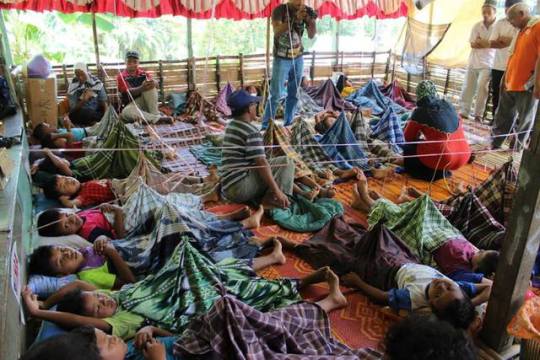


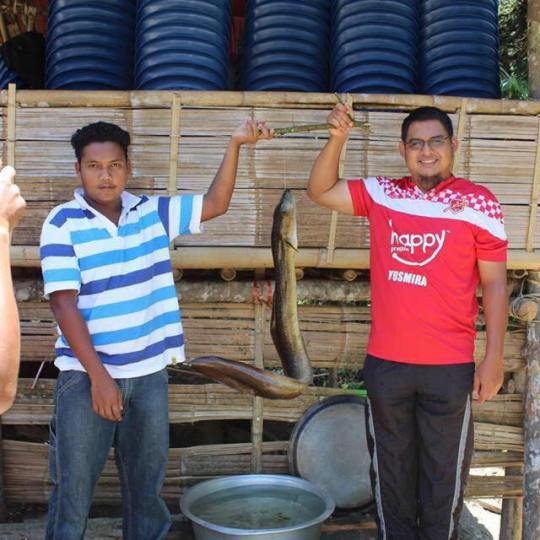

(via Livelihood Of The Orang Asli Temiar Kampung Landap, Perak)
Livelihood Of The Orang Asli Temiar Kampung Landap, Perak
Orang Asli which literally means “original people” or the “aboriginal people” in Malay is the official term used for the indigenous people of Peninsular Malaysia.
Orang Asli Temiar (Temiar) who are a Senoic group indigenous to the state of Perak and one of the largest of the 18 Orang Asli tribes of Peninsular Malaysia.
2 notes
·
View notes
Link
A fever. Shallow breathing. Racked by coughing. In May and June 2019, at least 15 Batek indigenous people of mainland Malaysia’s Kelantan state died with such symptoms. Some perished in the rainforest that had always sheltered their people, others in a settlement surrounded by oil palm plantations. A few passed away in hospital after the health crisis became known to the government.
Orang Asli, the indigenous peoples of mainland Malaysia, number less than 200,000 — under 1% of the country’s population. They include about 2,000 members of the Batek (also spelled Bateq) language group, who tend to have dark skin and curly hair. DNA studies indicate a Batek “deep ancestry” of at least 50,000 years in the region.
Dating back to post-WW2 counterinsurgency measures, Malaysian government policy has forced most Orang Asli into settlements, usually with dire results. But Bateks are some of the last roving forest foragers in the world.
With mainland Malaysia severely deforested in recent decades, Bateks now depend on protected forests, particularly Taman Negara (the National Park, their ancestral land) where they gather plants and hunt park-limited types of animals. They help prevent poaching, work as guides or build park structures. They also engage in unauthorised gathering of valuable fragrant gharu resin.
As many as 300 semi-nomadic Bateks are based near Kelantan State’s Kuala Koh entrance to Taman Negara in a small settlement of government-provided buildings and their own bamboo/tarp lean-tos. Except for the park access, the settlement is surrounded by the monoculture of erosion-prone Federal Land Development Authority (FELDA) oil palm plantations.
At Kuala Koh, the Bateks were not isolated from other communities, including Indonesian migrant oil palm and rubber laborers. It is not a particularly remote area. When I visited in 2008 while researching my book “The Wind in the Bamboo” it was only a 2 hour drive from the busy town of Gua Musang.
I sought out Chinloy, a woman who as a teenager in 1975 single-handedly shifted anthropology’s gender preconceptions (“men hunt, women gather”) when American field workers Kirk and Karen Endicott observed her skill at blowpipe hunting. In addition to their gender egalitarianism, Bateks are anthropologically significant for having a culture of nonviolence.
When I met Chinloy she was a mother of eight, including girls who hunted in the park. Batek students went to school in an oil palm workers’ village and returned home to the edge of the forest in the afternoon. I wrote that “the children seemed well-fed and well-dressed.”
Colin Nicholas, director of the Center for Orang Asli Concerns (COAC) has described the pre-2014 Kuala Koh Bateks as “healthy and happy people. And still in full control of their lives.”
Since then their circumstances have been severely reduced. A government program provided a piped water system that never worked. Catastrophic deforestation-related flooding in 2014-15 badly affected the river-dependent Bateks. According to COAC, “Their physical and mental health declined rapidly after that. And never really recovered.”
The Kuala Koh park entrance was described on TripAdvisor in 2018 as “dreary miles of oil palm plantations, unending… The river is muddy, forests disturbed…A heavy and oppressive atmosphere of decay”. As of January 2019, most of the children have dropped out of school because leaving their families for boarding schools has become the only option.
Dr Steven Chow of the Federation of Private Medical Practitioners Associations Malaysia was quoted in The Guardian about his April 2019 visit to the Kuala Koh Bateks: “Their water supply was virtually non-existent, sanitation was bad and they were suffering from all sorts of infections, showing their immune systems were very vulnerable”. The Bateks complained of an itching skin infection in March-April 2019.
When word of Batek deaths emerged in June, the press proclaimed a “mysterious disease” as if “the jungle” had perhaps produced some Ebola-like virus. Then pneumonia was identified as cause of death in some cases.
On 17 June, Health Minister Dzulkefly Ahmad issued the official diagnosis of a measles outbreak. Nothing tropical “jungle” about that, just unvaccinated or under-vaccinated children and adults with compromised immunity exposed to measles and succumbing to related pneumonia.
Although some Orang Asli have traditional beliefs opposed to piercing skin, Kuala Koh’s 61.5% initial vaccination rate and 30% second dose makes it seem likely that lack of access and medical staff neglecting follow-up inoculations were more of a factor than Batek reluctance to get the shots. Malaysia’s overall measles vaccination rate had sunk to 89% in 2018, when nearly 2,000 cases of the illness, with 6 deaths, were reported.
It seems that a variety of factors contributed to low immunity: scarcity of protein and other food shortages, contaminated water. Not only were the Kuala Koh Bateks living in proximity to the FELDA oil palm plantations and rubber plantations with agricultural chemical runoff affecting soil and water, there were iron and manganese mining operations nearby. A manganese mine was still functioning despite having its licence revoked in 2017 for environmental noncompliance.
The official measles diagnosis followed the Malaysian government’s denial that environmental problems were involved in the deaths. Deputy Prime Minister Wan Azizah Wan Ismail stated that a water sample test found no pollution from agriculture or mining.
Scepticism remains about those results. When local charity group Sahabat Jariah first brought outside attention to the Kuala Koh Batek deaths, it cited a university study of “the water in the surrounding rivers” which found “all sources of water are contaminated with metals, arsenic and agricultural chemicals.”
The Association for the Protection of Natural Heritage of Malaysia filmed some Kuala Koh Batek elder women, including Chinloy, speaking about the illness. One of them (as translated in The Malaysian Insight) said, “Before logging and mining commenced, nobody was ill or dead. Young people have died, babies in the womb also died.”
Chinloy’s husband Hamden Keladi, a respected community leader and three of their children, Laila, Romi and Din, died in the outbreak.
“I don’t know what has befallen me. I’ve never seen something like this before,” she told The Star newspaper, “I cry. I watch their graves.” Chinloy mentioned their living conditions: “When we don’t have water, we will use whatever we can get, including run-offs from an oil palm plantation.”
The Bateks clinging to the edge of the park are literally marginalised people. An 11 June COAC statement called the Batek deaths “a direct outcome of what happens when an indigenous community’s rights to the customary lands are not recognised, and the land destroyed and depleted in the name of progress and development.”
Orang Asli customary land rights are supposed to be protected by law but are instead constantly disregarded by Kelantan’s timber, agribusiness and mining interests. Temiar Orang Asli in the Gua Musang area have resorted to a series of blockades to prevent logging. In January 2019, Malaysia’s federal government filed a court case against the Kelantan state government for its failure to preserve Temiar traditional land from deforestation by plantation companies.
Now Bateks are returning home from hospital stays equipped with disposable masks. A charity announced they’ll furnish the Kuala Koh settlement with a solar powered water treatment system. Concerned Malaysians donated food and other supplies. The standard of healthcare will improve for a while.
Such sympathetic attention follows well-publicised Orang Asli deaths, like the five Temiar children who died in 2015 escaping one of the abusive boarding schools Malaysia still inflicts on indigenous children. This is a “vanishing races” syndrome in which land rights are never really respected and those considered fated to vanish are rarely consulted as equals.
Instead of sporadic, shocked attention driven by avoidable deaths, Malaysia’s Orang Asli communities need actual political and economic empowerment for their men and women. The Bateks, indigenous people of particular importance for their gender egalitarianism, nonviolence and botanical knowledge, must be included in all decisions affecting their lives.
Hamden Keladi told researcher Ivan Tacey back in 2008, “Our children when they live in the forest know how to live in the forest. They know how to hunt and find medicine in the forest”. With their expertise, the Bateks should be involved in the management of Taman Negara and supervise reforestation of their adjacent ancestral lands.
38 notes
·
View notes